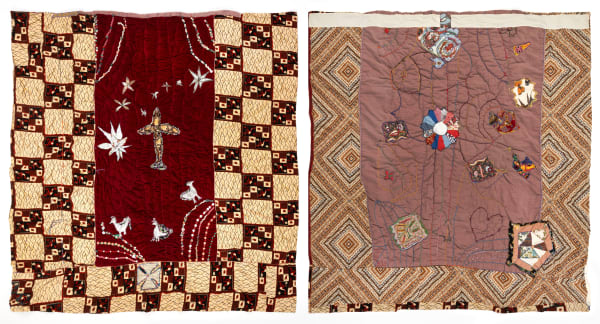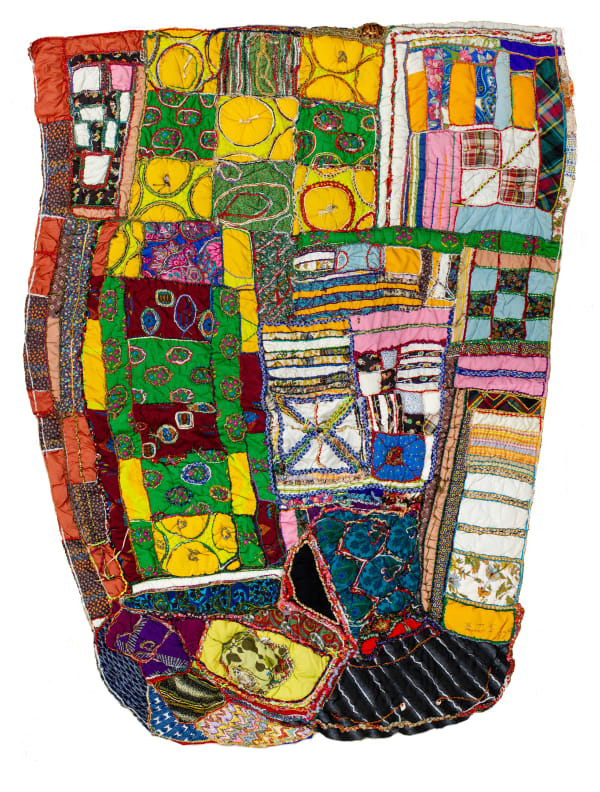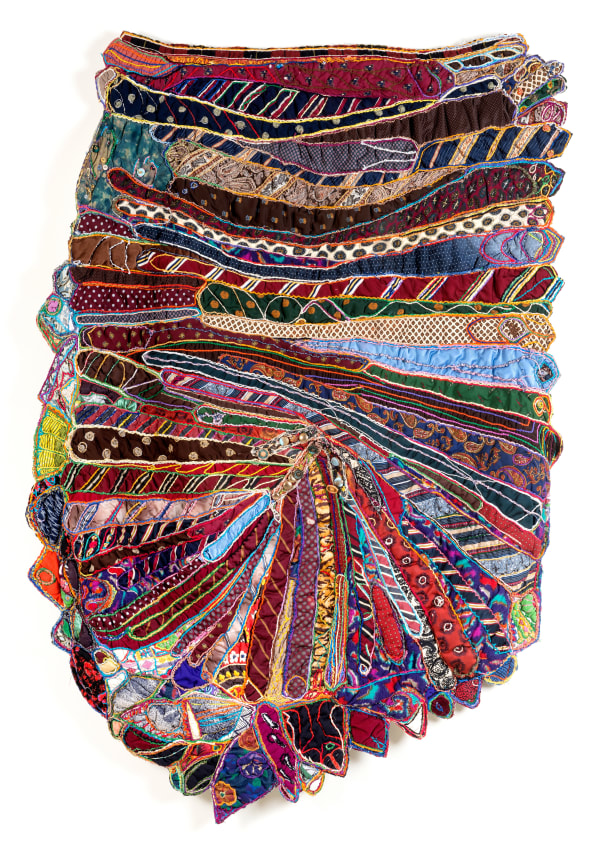-
 Person on a Swing, 1996Fabric, thread, yarn, buttons, rocks39 x 31 in. (991. x 78.7 cm)
Person on a Swing, 1996Fabric, thread, yarn, buttons, rocks39 x 31 in. (991. x 78.7 cm) -
 Flower Garden, 1989Fabric, thread, mixed media57 x 44 in. (144.8 x 111.8 cm)
Flower Garden, 1989Fabric, thread, mixed media57 x 44 in. (144.8 x 111.8 cm) -
 Upside Downwards, 1992Fabric, beads, buttons, ribbon, rocks, thread59 x 52.5 in. (149.9 x 133.3 cm)
Upside Downwards, 1992Fabric, beads, buttons, ribbon, rocks, thread59 x 52.5 in. (149.9 x 133.3 cm) -
 Stamp #2, Circa 1990sFabric, thread, mixed media65.5 x 63 in. (166.4 x 160 cm)
Stamp #2, Circa 1990sFabric, thread, mixed media65.5 x 63 in. (166.4 x 160 cm) -
 Birthday Quilt, 1994Fabric, silk ties, fiber ties, knots, thread, yarn60 x 52 in. (152.4 x 132.1 cm)
Birthday Quilt, 1994Fabric, silk ties, fiber ties, knots, thread, yarn60 x 52 in. (152.4 x 132.1 cm) -
 Birthday, 1997Fabric, thread, knots, sequins, faux pearls, ribbon, tulle, netting62 x 55.5 in. (157.5 x 141 cm)
Birthday, 1997Fabric, thread, knots, sequins, faux pearls, ribbon, tulle, netting62 x 55.5 in. (157.5 x 141 cm) -
 Abstract 27, 1993Fabric, thread, plastic, beads, buttons, pins, yarn30.5 x 33 in. (77.5 x 83.8 cm)
Abstract 27, 1993Fabric, thread, plastic, beads, buttons, pins, yarn30.5 x 33 in. (77.5 x 83.8 cm) -
 Bits and Pieces, 1995Fabric, beads, sequins, yarn, knots, buttons, metal, rocks, netting, thread53.5 x 53 in. (135.9 x 134.6 cm)
Bits and Pieces, 1995Fabric, beads, sequins, yarn, knots, buttons, metal, rocks, netting, thread53.5 x 53 in. (135.9 x 134.6 cm) -
 Underwater*, 1999Fabric, thread, mixed media38 x 21 x 2 in. (96.5 x 53.3 x 5.1 cm)
Underwater*, 1999Fabric, thread, mixed media38 x 21 x 2 in. (96.5 x 53.3 x 5.1 cm) -
 Untitled Prayers, Circa 1999Fabric, thread, mixed media28.5 x 15.5 in. (72.4 x 39.4 cm)
Untitled Prayers, Circa 1999Fabric, thread, mixed media28.5 x 15.5 in. (72.4 x 39.4 cm) -
 Three Generation Quilt I, 1983Fabric, thread57 x 46 in. (144.8 x 116.8 cm)
Three Generation Quilt I, 1983Fabric, thread57 x 46 in. (144.8 x 116.8 cm) -
 My Dreams, 1987-98Fabric, thread, mixed media71 x 57 in. (180.3 x 144.8 cm)
My Dreams, 1987-98Fabric, thread, mixed media71 x 57 in. (180.3 x 144.8 cm) -
 Tie Quilt #4*, 1995Fabric, thread, mixed media48 x 48 in. (121.9 x 121.9 cm)
Tie Quilt #4*, 1995Fabric, thread, mixed media48 x 48 in. (121.9 x 121.9 cm) -
 Untitled, Circa 1990sFabric, thread, yarn, buttons, rocks46 x 27 in. (116.8 x 68.6 cm)
Untitled, Circa 1990sFabric, thread, yarn, buttons, rocks46 x 27 in. (116.8 x 68.6 cm) -
 Both Sides Now: Turncoat, 1986-89Fabric, thread, cotton, silver lame, beads, natural and man-made fiber, rocks, buttons, beads, mixed media. Two sided86 x 86 in. (218.4 x 218.4 cm)
Both Sides Now: Turncoat, 1986-89Fabric, thread, cotton, silver lame, beads, natural and man-made fiber, rocks, buttons, beads, mixed media. Two sided86 x 86 in. (218.4 x 218.4 cm) -
 Save the Babies, 1992Fabric, thread, mixed media78 x 59 in. (198.1 x 149.9 cm)
Save the Babies, 1992Fabric, thread, mixed media78 x 59 in. (198.1 x 149.9 cm) -
 Flower Garden #1, 1989Fabric, mixed media55 x 55 in. (139.7 x 139.7 cm)
Flower Garden #1, 1989Fabric, mixed media55 x 55 in. (139.7 x 139.7 cm) -
 Tie Quilt #2, 1991Fabric, mixed media70.5 x 53.5 in. (179.1 x 135.9 cm)
Tie Quilt #2, 1991Fabric, mixed media70.5 x 53.5 in. (179.1 x 135.9 cm)
Goya Contemporary Gallery is pleased to present:
Elizabeth Talford Scott: Upside- Downwards
Goya Contemporary Gallery
20 November 2020 - 28 January 2021
Elizabeth Talford Scott (1916-2011) was born near Chester, South Carolina on the land her parents worked as sharecroppers, and where previously her grandparents were held as slaves. The sixth of fourteen children who lived on the Blackstalk Plantation, Elizabeth was trained by age nine to repurpose scrapped materials into usable objects to accommodate basic survival needs. Quilting was a familiar part of the black American experience, especially within the South. It was a keystone for innovation, recycling, constructed iconography, and passing historical narratives from one generation to the
next. The artist honed her quilting skills at a young age, though her invention within the medium would develop over many years, moving away from domestic function into wall hangings that live squarely within the vernacular of fine art.
The exhibition Elizabeth Talford Scott: Upside- Downwards includes more than 20 objects that reveal this important American artist and her influential practice. “Elizabeth Talford Scott’s works are akin to visual diaries,” says Amy Eva Raehse, Director & Partner at Goya Contemporary “In a time when some institutions are just starting to represent the stories of black and brown America, our 25 years sharing these narratives help us underscore that blackness is not monolithic. There are shared experiences, and of course, there are very personal and individual experiences. Elizabeth’s practice intertwined the two in dynamic and pioneering ways.
”Migrating to Baltimore in the early 1940’s, Elizabeth and Charlie Scott, Jr., welcomed into the world their daughter, celebrate artist and MacArthur fellow Dr. Joyce J. Scott. During this period, Elizabeth Scott worked as a caterer, a caregiver to children, and a mother. With limited time in her demanding work schedule, Elizabeth Scott took a hiatus from quilting. It was not until her daughter was self-sufficient, in the 1970’s, that the artist returned to her creative practice with dedication, vigor and potency. Developing techniques that acknowledged her family history yet moved beyond, Scott began to innovate, creating Fiber works that incorporated stones, buttons, shells, bones, sequence, beads,knotted material, glass, and other unconventional objects amassed in bright and lively compositions that boasted bold colors and heavily layered surfaces in organic and unstructured shapes.
Immersed and embedded within the lush surfaces of these works, live personal and worldly narratives and an alphabet of symbols that tell us as much about emotion as they do about personal history. A developed iconography makes use of references to nature, flowers and animals, insects, sea creatures, monsters and fantastical beings, magic, superstitions, and good luck charms which converge in a cacophony of pure visual energy. In Scott’s hands, commonplace materials are transformed into a lesson in abstract design informed by all that she could see and imagine.
During her lifetime, Elizabeth exhibited in Baltimore as well as national venues including The Studio Museum of Harlem, NY; The Museum of American Folk Art, NY; and The Metropolitan Museum of Art. In 1998, she was the subject of a retrospective exhibition titled Eyewinkers, Tumbleturds, and Candlebugs: The Art of Elizabeth Talford Scott that opened at the Maryland Institute College of Art and traveled to the Smithsonian Institution’s Anacostia Community Museum in Washington, DC among other venues in New England and North Carolina. In 1987, Elizabeth Talford Scott was bequeathed the Women’s Caucus Award for Outstanding Achievements in the Visual Arts. The artist regularly produced workshops, frequently collaborating with her daughter, Joyce J. Scott, to educate students on methods and material usage in her craft.
Goya Contemporary Gallery has remained the worldwide, primary dealer representing MacArthur fellow Joyce J. Scott for nearly 25 years. “…Naturally we wanted to undertake the estate of Elizabeth Talford Scott in an effort to tell their unique mother-daughter legacy story. These multi-generational artists learned from, and taught, one another…” said Raehse “…they shared principles and techniquessometimes even materials, and yet their works convey individual truths.”
Elizabeth Talford Scott died in 2011. In 2019, Scott was the joint subject of the exhibition Hitching Their Dreams to Untamed Stars: Joyce J. Scott & Elizabeth Talford Scott at the Baltimore Museum of Art. That same year, the duo was also the subject of Reality, Times Two: Joyce J. Scott & Elizabeth Talford Scott at their primary gallery, Goya Contemporary Gallery, in Baltimore. In 2020 and beyond, E.T. Scott will be part of several museum exhibitions including at the Philbrook Museum and the Mint Museums. Her Posthumous success points to a long standing, systemic institutional structure that failed to recognize the work of significant female makers in their lifetime, but one that has prompted reinvestigation into these important practices.
Elizabeth Talford Scott has been cited by many contemporary, celebrated artists as an influence, counting her own daughter, Joyce J. Scott among those she influenced. E.T. Scott’s works feel as fresh and relevant today as the day they were constructed, proving Scott a significant artist who was not only of her time, but ahead of her time…if not, timeless.
























